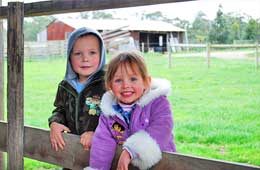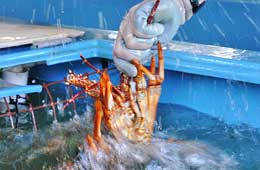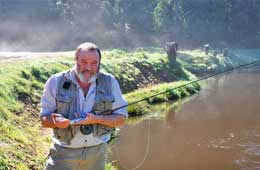The Age
Gone are the days when education simply meant sending the children to the nearest public school, or if the family could afford it, to a private school. Parents today can choose an education model that suits their family arrangements and their children’s needs, and follow directed or self-guided curriculums. Options include religious, Montessori, Steiner, Reggio Emilia and Home Schooling.
Thousands of Victorian children have been schooled at home, and in the past two years, it has grown threefold here and worldwide; this year an estimated 4000 Victorian children will be home schooled.
Susan Wight, co-ordinator of the Home Education Network, a volunteer advocacy and support organisation, says home schooling is a recognised, legal and viable alternative to various mainstream schooling options.
According to the state government guide Home Schooling in Victoria, published in March 2010, the Education and Training Reform Act 2006 requires that all children of compulsory school age (6 to 17) who are home schooled be registered with the Victorian Registration and Qualifications Authority.
Mrs Wight says home-schooled children have the same options for entering tertiary studies that are available to those from public and private schools. Some parents home-school their children through primary grades and then enrol them into schools for the VCE years; other choices include Open University, the AYCE (Access Yea Community Education) program, university entrance tests, exams or programs, TAFE and bridging courses.
Mrs Wight says parents choose to home-school their children for a variety of reasons and manage it in different ways. Some have a more structured environment, she says, but most take a less formal approach.
Some families choose to home school one child while another is in school – it depends on what they believe will suit each child best. ‘‘There are also people that home school part-time or have children that attend school for a particular subject,’’ she says. ‘‘Schools are required by the Education Act to cater for this, as long as it doesn’t take them over their numbers.’’
Kim and Michael Versteden sent their children to the local public school but removed them in 2005 in favour of home schooling.
The couple run their own business and live in a small town in Gippsland with their children, Scott, 17, Kaitlin, 15, and Ryan 13. Their eldest child, Wade 19, is away working in Western Victoria.
Mrs Versteden says she and her husband were unhappy sending their children to school but didn’t know there were options. ‘‘I thought kids who went to school were put in the same environment with the same bunch of kids, for the same amount of time, with the same teacher, were taught the same way and they wore the same clothes,’’ she says. ‘‘Everything was the same, the same. It didn’t cater for children’s individual needs.’’
She believes home schooling has allowed the children ‘‘to learn the way they are wired to learn. It might be more hands on, more abstract or more textbook – depending on who they are and where they’re at.’’
The Verstedens were also dissatisfied with their children’s academic accomplishments. ‘‘They spent so much time at school and yet at the end of grade six, Wade couldn’t spell and Scott was struggling,’’ Mrs Versteden says.
There were also social issues at the school. Mrs Versteden, a classroom helper at the school, observed several instances of bullying, some involving her children.
Before taking the children out of school, she attended some home school group activities and found the environment was very different, more co-operative than competitive. Children of all ages and backgrounds and their parents interacted together.
Home schooling is not a situation where a parent is the teacher and the children are students, Mrs Versteden says, it’s a family or group of people learning and working together. ‘‘When we started, it was harder to home school Wade and Scott, more than Kaitlin and Ryan, because they were so used to being directed and they didn’t want to do school work. So for a while we didn’t do much apart from a little bit of maths. We just went to different places and they played,’’ she says.
‘‘I got Scott to build a cupboard. I told him where I wanted it and how many shelves I wanted, so he would have to measure it up, design it, then make it and that was how I got him to rethink his attitude. After that, the children’s curriculum worked around following their interests, and for that reason, they retained what they learnt more than they did when it was to pass a test,’’ she says.
‘‘It’s all relative to what they need to know at that time and often what they don’t like then will become an interest later,’’ she says.
‘‘There are times when Kaitlin will come to me with a maths problem and I’ll have to work it out myself to help her, but I think it’s good for them to see me work things out because it shows them how to do it. It’s also good for them to see us struggle doing something because they then don’t feel like a failure when they are struggling, and it’s amazing how many things I’ve learnt since we started home schooling.’’
Mrs Versteden believes home schooling has given the children a well-rounded education. ‘‘They don’t need the authority of their friends to do things. They know who they are, what they want, and they’re not afraid to do it.’’
The booklet Home Schooling in Victoria outlines services and support available to families who home school their children. This includes information on:
- registering a child for home schooling
- developing a home schooling program
- Victorian school curriculum support
- home schooling support networks
- financial support
- partial enrolment and community-based education options
- post-compulsory pathways.
The Education and Training Reform Act 2006 requires that education in Victoria is consistent with the principles and practice of Australian democracy and that all education programs, including home schooling programs, address the eight key learning areas, as a condition of registration.
- The Arts
- English
- Health and Physical Education
- Languages other than English
- Mathematics
- Science
- Studies of Society and the Environment
- Technology
Parents who choose to home school their child assume overall responsibility for the planning, implementation and assessment of their child’s educational program. As such, a home schooling education program should enable each child to:
- realise their learning potential.
- maximise their education and training achievement.
- develop enthusiasm for lifelong learning.
The delivery style of the program can vary from informal learning approaches to formal curriculum programs, depending on the child’s learning needs and individual circumstances.
education.vic.gov.au/aboutschool/enrolling/homeSchool.htm
Home Education Network: home-ed.vic.edu.au
By Wendy Morriss
Copyright © 2013 Wendy Morriss: Freelance Journalist. All Rights Reserved.





